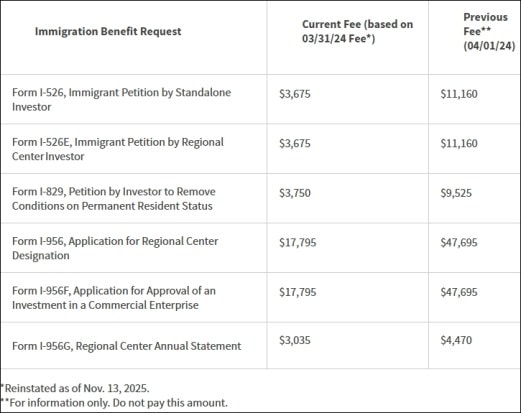The EB-5 fee battle has taken a sudden turn when a federal judge found that USCIS had illegally increased investment visa filing costs. Following the November 12 order, USCIS stated that it disagrees with the decision but will comply, reverting to pre-April 2024 costs with limited exceptions for submissions postmarked by November 26, 2025.
U.S. District Court, in a recent judgment, has ruled that USCIS had unlawfully increased the filing fees for EB-5 petitions and applications and partly stayed the fee increases, based on arguments on the merits. On November 12, the United States District Court for the District of Colorado issued a decision staying certain EB-5 related fees that were codified by DHS in the 2024 Fee Rule, which became effective April 1, 2024.
USCIS EB-5 Update
However, in a statement released by USCIS, the Department of Homeland Security (DHS) and the United States Citizenship and Immigration Services (USCIS) find the Court’s decision on EB-5 fee hike to be incorrect, but are working to implement it.
In accordance with the November 12 order, and effective immediately, USCIS will accept the fees that were in effect until March 31, 2024, which are listed in the “Current Fee” schedule below.
Petitioners and applicants should pay fees according to the “Current Fee” schedule, not the higher “Previous Fee” schedule.
However, for items postmarked November 26, 2025, or earlier, USCIS will also accept payment of the “Previous Fee.” For items postmarked after that date, USCIS will reject petitions or applications that are accompanied by the “Previous Fee.”

The regulation in question raised the filing fee for I-526/I-526E petitions from $3,675 to $11,160, an increase of 204 percent. Form I-526 is used for Immigrant Petition by Standalone Investor.
Additionally, it raised the filing fee for I-829 petitions from $3,750 to $9,525, an increase of 154 percent. Form I-526E is used for Immigrant Petition by Regional Center Investor.
Furthermore, for EB-5 regional centers, it raised the fee for I-956 and I-956F applications from $17,795 to $47,695, an increase of 168 percent. Apart from these fees, USCIS also levied a mandatory “Asylum Program Fee” of $300 or $600 on some petitioners.
Court Ruling
In addition to the statutory requirements of investments of $800,000 to $1,050,000, EB-5 investors also have to pay legal fees to attorneys, administrative fees to regional centers, currency swap costs, and other fees associated with starting a new life as a U.S. resident.
Therefore, the dramatic increase in EB-5 filing fees, by over 100 percent in each category, severely affected EB-5 investors.
The American Immigrant Investor Alliance (AIIA), together with other plaintiffs, noted this key judicial win against the Department of Homeland Security (DHS) and the United States Citizenship and Immigration Services (USCIS) over the controversial EB-5 fee hike.
The judge ruled that USCIS had violated Section 106 of the EB-5 Reform and Integrity Act of 2022, which requires USCIS to conduct and publish a “fee study” on EB-5 fees before changing those fees. The judge also found the agency actions to be “arbitrary, capricious, and not in accordance with law,” pursuant to the Administrative Procedure Act (APA), as AIIA had pleaded.
Department of Justice (DOJ) attorneys have conferred with AIIA legal counsel and have confirmed that the old fees, applicable before April 1st, 2024, are now in effect.
The DOJ attorney has confirmed that EB-5 investors filing Form I-526/E or I-829 may submit payment using the previously applicable, lower filing fees, which were reinstated by the Court’s decision. The same applies to regional center I-956/F/G petitions.
According to AIIA, they have also been notified that USCIS is slowing down the automated processing of EB-5 petitions and switching to manual processing to ensure that their systems software does not inappropriately reject petitions for including the “wrong fee”.
The court’s ruling in this case does not end the litigation. The judge’s order merely enters a “stay” of the rule pending judgment, meaning that it may not be enforced until a final resolution of the case.
Plaintiffs are already conferring with the Defendants, i.e., the U.S. Department of Homeland Security, on the case and will file a “Joint Status Report” with the court on or before January 12, 2026. The Defendants may appeal the stay to the U.S. Court of Appeals for the 10th Circuit.

